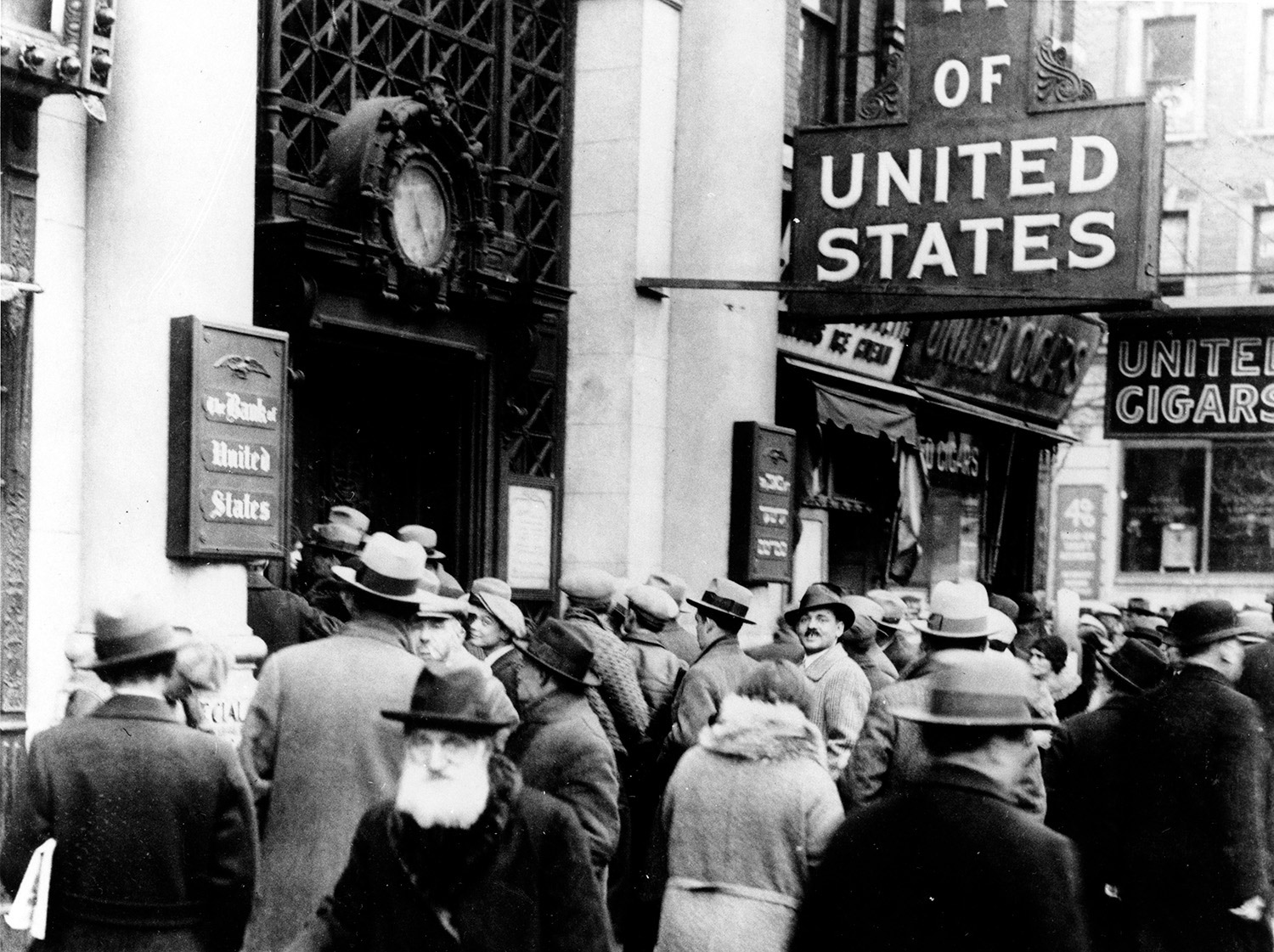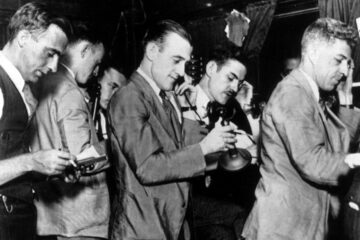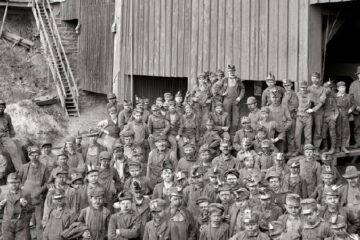What Happened in Business: 1930
| « 1929 | 1931 » |
 Summary: Great Depression ↓
Summary: Great Depression ↓
U.S. President: Herbert Hoover (1929-1933)
DJIA End of Year Close: 164.58
Common Stocks: United States Steel Corporation, Procter & Gamble (PG), American Telephone and Telegraph (AT&T), General Electric (GE)*
Media: Newspaper, Mail, Magazine, Catalogs, Telegraph, Typewriters, Photography, Telephone, Radio, Phonograph
Wealthy Americans: John D. Rockefeller, Andrew Mellon, Henry Ford
U.S. Population: 123 million
Era: Beginning of the Great Depression
Key Events & Dates
Great Depression Continues (1930): The stock market experiences the fallout from the “Wall Street Crash of 1929,” leading to ongoing economic challenges, bank closures, and widespread unemployment.
Unemployment (1930): In 1930, more than four million people were unemployed as a result of the Wall Street Crash of 1929.
Bank Runs & Banks Fail (December 1930): The Bank of the United States, a major commercial bank, collapses in December, causing a ripple effect in the banking industry and contributing to the banking crisis of the era.. Unable to pay out to all of its creditors, the bank failed. Among the 608 American banks that closed in November and December 1930, the Bank of United States accounted for a third of the total $550 million deposits lost and, with its closure, bank failures reached a critical mass.
Chrysler Building Completed (May 1, 1930): The iconic Chrysler Building in New York City is completed, becoming the world’s tallest building and a symbol of American innovation.
Industrial Recovery Act of 1930 (July 8, 1930): President Herbert Hoover signs the Industrial Recovery Act into law, a precursor to later New Deal legislation aimed at stabilizing the economy during the Great Depression.
Construction of the Empire State Building Begins (August 11, 1930): Construction commences on the Empire State Building, which would become one of the most famous skyscrapers in the world.
Smoot-Hawley Tariff Act (October 28, 1930): President Hoover signs the Smoot-Hawley Tariff Act into law, raising tariffs on imported goods, which some economists believe exacerbated the Great Depression.
Bank of the United States Fails: The Bank of the United States, a major commercial bank, collapses, causing a ripple effect in the banking industry and contributing to the banking crisis of the era.
Prohibition Repeal Debate Begins: As the Great Depression continues, discussions about the repeal of Prohibition gain momentum, eventually leading to the 21st Amendment in 1933, which ended the nationwide ban on alcohol.
U.S. Population Census (April 1, 1930): The U.S. government conducts the 1930 Census, providing crucial demographic data for businesses and policymakers.
November Banking Crisis: In November 1930, a series of crises among commercial banks turned a recession into the beginning of the Great Depression.
First Supermarket (August 4, 1930): The first U.S. supermarket, King Kullen, opened in Queens, New York. This store was the first to combine the high volume and low cost that are the hallmarks of the U.S. supermarket.
President Hoover’s Public Works Program (December 2, 1930): President Herbert Hoover asked Congress for a US$150 million public works program to help generate jobs and stimulate the economy.
Richard Drew Invents Scotch Tape (September 8, 1930): This invention by a 3M engineer marked a major advancement in office supplies and consumer goods, eventually becoming a staple product worldwide.
First Frozen Food Sold by Clarence Birdseye (1930): The introduction of frozen foods for sale by Clarence Birdseye revolutionized the food industry, changing consumer habits and food preservation methods.
U.S. Economic Landscape in 1930
The U.S. economic landscape in 1930 was characterized by significant challenges and hardships due to the ongoing Great Depression, which had been triggered by the stock market crash of 1929. Here is an overview of the economic conditions and key features of the U.S. economic landscape in 1930:
Great Depression: The Great Depression, which began in late 1929, was in full swing in 1930. This economic downturn was one of the most severe in U.S. history. It was marked by a collapse in industrial production, widespread unemployment, bank failures, and a sharp decline in consumer spending.
Unemployment: Unemployment rates soared during the Great Depression. By 1930, millions of Americans were out of work, and unemployment reached unprecedented levels, with some estimates suggesting rates as high as 8-10% at the beginning of the year.
Bank Failures: The banking sector faced a crisis, with numerous bank failures occurring throughout the year. Many banks were unable to recover from the financial shocks of the stock market crash and the subsequent economic turmoil.
Agricultural Crisis: The agricultural sector was hit hard by the Depression. Falling crop prices and widespread drought in certain regions led to a devastating agricultural crisis. Farmers struggled to make ends meet, leading to rural poverty and migration to urban areas.
Trade and Tariffs: The U.S. government, in an attempt to protect domestic industries, passed the Smoot-Hawley Tariff Act in 1930. This act raised tariffs on imported goods, which led to retaliatory tariffs by other countries and a decline in international trade.
Consumer Spending: Consumer spending plummeted as people lost confidence in the economy. Many individuals and families cut back on discretionary spending, contributing to reduced demand for goods and services.
Housing Crisis: The housing market suffered as construction slowed down, and homeowners faced difficulties in paying their mortgages. Home prices declined, and foreclosure rates increased.
Government Response: President Herbert Hoover’s administration implemented various measures to address the economic crisis, but these efforts were largely ineffective in reversing the downturn. The Hoover administration struggled to find solutions to the worsening economic conditions.
Public Works Projects: To combat unemployment and stimulate economic activity, some public works projects were initiated at the federal and state levels. However, these initiatives were insufficient to counter the broader economic challenges.
Debate Over Economic Policy: There was a growing debate over economic policy, with some advocating for increased government intervention and others emphasizing a more laissez-faire approach. These discussions would later influence the policies of Franklin D. Roosevelt’s New Deal in the early 1930s.
Overall, the U.S. economic landscape in 1930 was marked by the devastating effects of the Great Depression, including high unemployment, bank failures, declining industrial production, and widespread economic hardship. It was a challenging year for the American economy, with significant repercussions for both individuals and businesses.
Consumer Brands of the Era
In the year 1930, several consumer brands were well-established and recognized in the United States. These brands offered a range of products that were popular among consumers during that era. Here are some common consumer brands that existed in 1930:
- Coca-Cola: Coca-Cola was already a widely recognized and popular brand, known for its carbonated soft drinks.
- Kellogg’s: Kellogg’s, the cereal company, offered breakfast cereals such as Corn Flakes and Rice Krispies.
- Campbell’s: Campbell’s was known for its canned soups, which became a staple in American households, especially during the Great Depression.
- Procter & Gamble: Procter & Gamble produced a variety of consumer products, including Ivory soap, Crisco cooking oil, and Pampers.
- Ford: The Ford Motor Company continued to be a major player in the automotive industry, with the Model A and other vehicles.
- General Electric (GE): General Electric was known for its electrical appliances and household products.
- Chevrolet: Chevrolet, a division of General Motors, manufactured a range of automobiles that were popular among consumers.
- Kodak: Eastman Kodak Company was well-known for its cameras and film products, enabling people to capture memories through photography.
- Pepsi-Cola: Pepsi-Cola, though not as established as Coca-Cola, was a notable player in the soft drink industry, offering an alternative to its famous rival.
- Wrigley’s: Wrigley’s chewing gum was a popular treat, available in various flavors.
- Morton Salt: Morton Salt was recognized for its iconic “When it rains, it pours” slogan and packaging.
- Jell-O: Jell-O, a product of General Foods, was a popular dessert and snack.
- RCA (Radio Corporation of America): RCA was a leader in consumer electronics, manufacturing radios and phonographs.
- Quaker Oats: Quaker Oats Company offered oatmeal and other cereal products.
- A&P (The Great Atlantic & Pacific Tea Company): A&P was a prominent grocery store chain, providing a wide variety of food products and groceries.
These brands and their products played a significant role in American households and everyday life during the 1930s, offering convenience, comfort, and enjoyment to consumers during a challenging economic period.
Key Leaders, Innovators, & Influencers of the Era
In the year 1930, there were several important business leaders and influencers who made significant contributions to various industries and played key roles in shaping the business landscape of that era. Here are some notable figures:
Henry Ford: Henry Ford, the founder of the Ford Motor Company, remained a prominent figure in the automotive industry. While the Model T had already made Ford a household name, he continued to influence the industry with the introduction of the Model A in 1927.
John D. Rockefeller Jr.: The son of the famous oil magnate John D. Rockefeller, John D. Rockefeller Jr. was a prominent philanthropist and businessman. He was involved in various industries and was known for his charitable contributions.
Thomas J. Watson Sr.: Thomas J. Watson Sr. was the founder and CEO of International Business Machines Corporation (IBM). Under his leadership, IBM continued to grow and diversify its business.
Alfred P. Sloan Jr.: Alfred P. Sloan Jr. was a key figure in the automobile industry as the President and CEO of General Motors. He introduced innovative management and marketing techniques that helped GM thrive.
Walt Disney: Although best known for his contributions to the entertainment industry, Walt Disney was also a shrewd businessman. In 1930, he founded the Disney merchandise licensing division, which laid the groundwork for Disney’s extensive merchandising empire.
Harland Sanders: Harland Sanders, known as Colonel Sanders, began selling his famous fried chicken recipe from a service station in Kentucky in the 1930s. This eventually led to the founding of Kentucky Fried Chicken (KFC).
J.C. Penney: James Cash Penney, the founder of J.C. Penney department stores, continued to expand his retail empire during the 1930s. His business philosophy emphasized quality and affordability.
Charles Merrill: Charles Merrill co-founded Merrill Lynch & Co. in 1914. In the 1930s, Merrill Lynch continued to be a significant player in the financial services industry.
Thomas Lamont: Thomas Lamont was a prominent banker and senior partner at J.P. Morgan & Co. He played a crucial role in financial matters during the era, including helping stabilize the U.S. financial system during the Great Depression.
* Stocks are examples of some of top, popular traded stocks; however, exact data not available.
Main Image Source: FDIC.gov
Content Sources: Original | Generative AI | Wikipedia
| « 1929 | 1931 » |


